Babywearing can be very practical and beneficial, both for parents and the baby. When you’re carrying your baby in a wrap, sling or classic carrier your hands are free and you can do your household chores, make a meal or play with your older child.
It’s also very useful when you’re going shopping, using the public transportation or trying to get through crowded airport. And of course, if you’ll practice it a bit, you can also use the carrier during breastfeeding.
For many babies being so close to their caregivers, feeling their warm and heartbeat is soothing. It also helps to strengthen the bond between parent and baby.
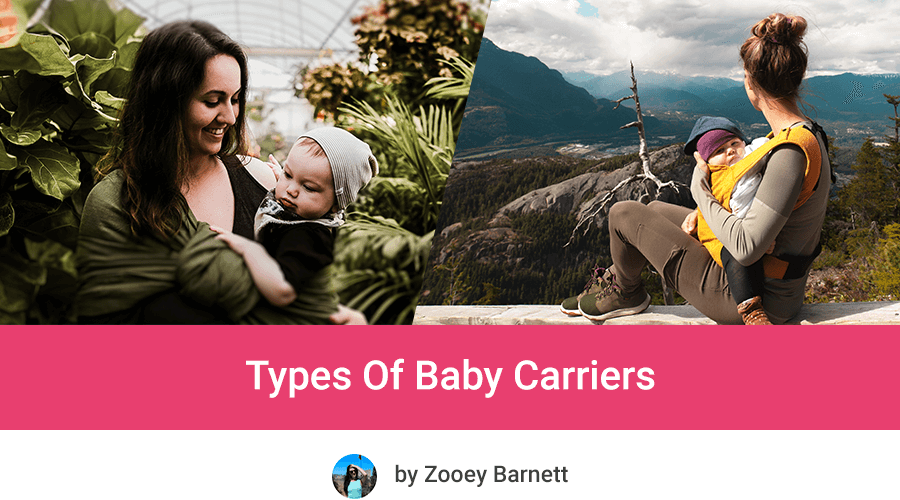
Of course the situation with baby carriers is exactly the same like with other baby gear – there are so many different brands, types and model on the market! You can get dizzy when you’re trying to find the best carrier for your baby.
That’s why I decided to expand LittleBabyGear a bit and use my experience as a mom to help you choose the right carrier.
First thing that you should do is to pick one type of baby carrier that suits your needs best. It will help you to narrow down your choice to few options.
Below you can see all the basic types of baby carriers that we can find on the market today – I marked the features that parents love and functions that parents usually complain about.
5 Types Of Baby Carriers – Main Features, Pros & Cons
There are basically 5 types of baby carrier: wrap, ring sling, pouch, soft-structured carrier (also called buckle carrier), meh dai (mei-tai) and backpack.
1. Wrap
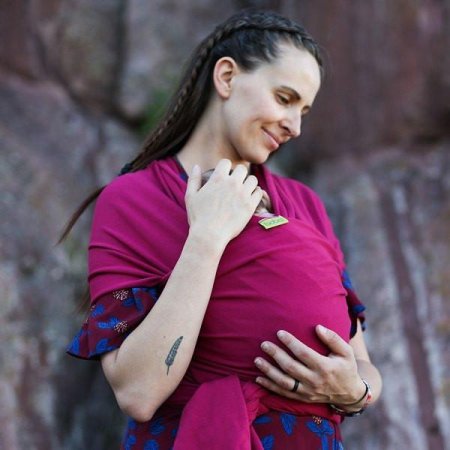
This is the most traditional and simple type of baby carriers (but not the easiest one, especially for babywearing beginners). Wrap is a long piece of fabric that you need to wrap around your body and your baby.
By tying loose ends you create a snug, cozy and secured place for your baby. There are few different ways of tying the wrap around your body which may be a little difficult at the beginning, but as you practice it few times it gets much easier.
You can find on the market many different wraps, some of them are shorter or longer, some are made of cotton knit, gauze (which provides good breathability, excellent for hot weather), cotton, wool, linen or other fabric.
Wraps that are made of elastic fabric like cotton jersey or knit jersey, are called stretchy wraps. They are great solution for babywearing-beginners and generally for newborn babies. With stretchy wrap you tie the fabric around your body first and then you stretch it over the baby.
Wraps that are made of cotton, linen, wool or hemp are called woven wraps. These types of fabrics make the wrap more sturdier. Woven wraps are recommended especially for toddlers and older kids and for wearing baby on your back.
Would you like to start you babywearing journey with wraps? Choose one of the best wrap baby carriers: Boba Baby Wrap Carrier, Baby K’tan Original Baby Carrier, Moby Wrap Evolution, Classic Moby Wrap, Ergobaby Wrap and Lillebaby Tie The Knot Wrap.
2. Ring Sling
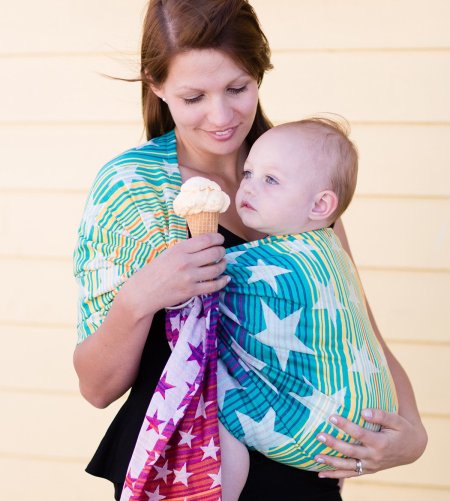
This is also a long piece of fabric (usually about 2 meter long) which has two rings at one end. To fasten it you need to thread the free end through one ring and then tuck it under the other ring. This way you can adjust it to your body and find the perfect snuggle for your baby. You don’t have to worry the sling will unfasten itself – baby’s weight prevents the rings from slipping.
Ring Sling creates a pouch for the baby, that comes from one shoulder to the opposite hip. It allow you to wear your baby in front of you or on your hip (most popular way).
Notice that ring slings are not made of stretchy fabrics. Usually this type of baby carrier is made of cotton or linen. You can also find a ring sling made of luxurious silk.
If you compare these two types: ring sling vs wrap, you can notice few differences. Some of the wraps are stretchy, while ring sling are rather made of woven fabric
With wraps you have to learn to make a secure tie, with ring slings you have adjustable fastening with two rings (no need to tie anything).
If you think this type will suit your needs best, you should try these top ring slings: Pura Vira Luxury Ring Sling Baby Carrier, Hip Baby Wrap Ring Sling, Lillebaby Ring Sling and Baby Tula Ring Sling.
*Pouch Sling*
This is a different version of ring sling carrier. It’s not very popular, so I’ll just mention few words about it. It works similar to ring slings but here you don’t have any rings that would allow you to adjust its length. Here you have a simple long loop of fabric that goes across your body – from one shoulder to opposite hip. Just like a sash. It allow you to wear the baby on your hip (most comfortable), as well as in front of you (best for newborns). Pouch sling is very easy to use and inexpensive.
| The main difference between pouch slings and ring slings is that the former one comes in sizes. It doesn’t allow you to adjust its size as your baby grows and it’s really hard to share it with other caregivers (unless they have very similar body type). Another drawback is that pouch is not good for wearer’s back. Baby’s weight is not evenly distributed across your body so it may cause back and shoulder pain. |
3. Soft Structured Carrier (SSC) / Buckle Carrier
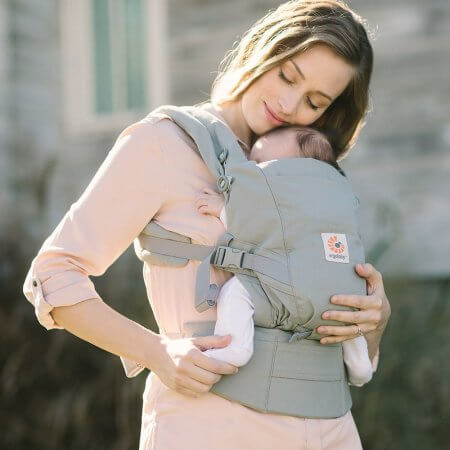
This is probably what most parents have in mind when they think about baby carriers. Soft structured carriers come with padded shoulder straps and thick, padded waistband that you need to fasten around your waist. Once you’ve done that the fabric creates a pouch for the baby. The panel (the fabric on the bottom where the baby sits in) should be wide enough to provide the support for baby’s hips and legs, from one knee to knee.
Usually all straps are adjustable which allow wearer to find most comfortable and ergonomic fit. It also helps to evenly distribute baby’s weight across caregiver’s body. What’s really great about this type of baby carriers is that you can use them on your front and back and sometimes even on your hip.
Soft structured carriers that have proper, wide panel allow the baby to rest in most healthy position – with the hips bent and spread apart to the side, thighs supported, knees bent and higher than bum (it’s called frog position or spread-squat position). This position is most natural for infants, it promotes natural hip development and reduces the risk of hip dysplasia or dislocation.
| PRO TIP: Avoid soft structured carriers with narrow panel (seating area) where baby’s weight puts pressure on his/her crotch and his/her legs are straighten and dangle. This position strains baby’s spine, doesn’t support his legs and hips and may have negative impact of they development. And it’s not comfortable for the baby either! More about proper hip positioning you can read in my article about baby carriers safety. |
Most of the buckle carriers are suitable from 4-5 months, when the baby has better neck and head control. Some soft structured carriers are suitable for newborn babies however often they require adding an infant insert.
If you’d like to use a buckle carrier for your newborn baby I recommend you getting one that doesn’t require this additional insert. They are less bulky and hot. Besides, with an insert may be more difficult to find the proper position for the baby. Read more about it in my article about safest baby carrier for newborn.
There are few soft structured baby carriers that are usable for newborn baby without an insert: Tula Free-to-Grow, Boba Carrier, Ergobaby Omni 360, Lillebaby The Complete Airflow 360° (from 7 lbs) and Beco Gemini.
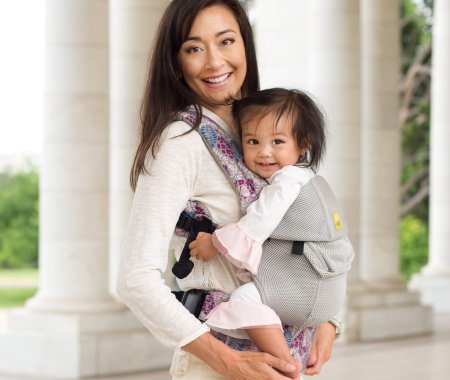
Some of the buckle baby carriers offers really huge adjustability and versatility. For example some models allow you to adjust the sitting area in width to find the best and safest position for the baby as he/she grows. Thanks to that you can use one baby carrier from infancy to toddlerhood.
Moreover, many soft structured carriers have storage pockets which are actually quite useful. Thanks to that you can keep some tissues or a teether always at hand.
4. Meh Dai (Mei Tai) Carrier
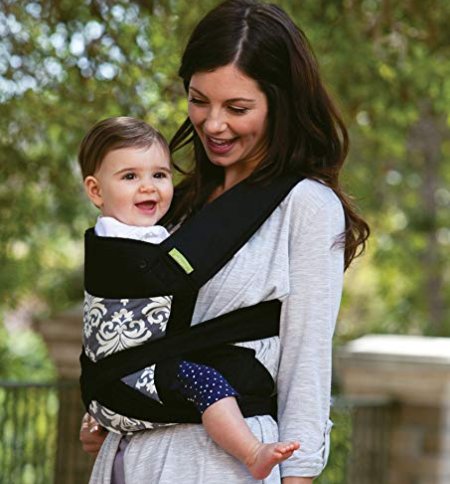
This is a hybrid carrier combines features of a wrap and buckle carrier. Usually Mei-Tai looks similar to soft structured carrier, but here you have long pieces of fabric that you need to tie properly around your body. There are two shoulder straps and a two straps that you need to tie around your waist. So instead of buckles, here we have ties.
Mei-Tai is highly adjustable and can be easily shared between different caregivers – you just need to adjust its tightness. Of course you have to learn how to make a secure tie, but it’s not that difficult and definitely takes less practice than for example wrap carrier.
You can wear this type of baby carriers on your front, back or hip. Some of the Mei-Tais are suitable for older infants (from 6 months), but few models can be used from birth as well.
5. Backpack Carriers
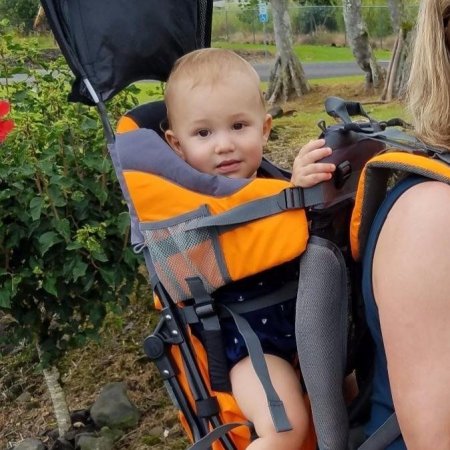
This type of baby carriers is designed for wearing like a backpack and it can be used only for children who can sit unassisted and have good neck control.
Here the seat is framed and the baby stays in sitting position the whole type.
Usually backpack carriers have padded shoulder straps and additional straps that you should fasten around your waist and chest. It’s not only more secured for the baby this way, but also helps with proper weight distribution.
Backpack carriers are useful for wearing the baby for longer period. Some of them are designed for hiking, walking in the woods etc. If you want your toddler or preschooler to keep you company during exploring outdoors, this is the best and most comfortable solution.
If you plan on taking your little one on your outdoors adventures, you need a good-quality and safe carrier. Check my article about best baby carriers for hiking and prepare for your exploration properly.
| PRO TIP: If you don’t need a carrier for hiking, but you love an idea of carrying your toddler on your back, you can go with classic buckle carrier – just choose a model that offers this position. |
Some models of backpack carriers are equipped with few storage pouches where the child can keep small toys, snack or sippy cup. Some have also a stand that you can easily fold out when needed. This makes putting baby in and out of it much easier.
You can find my ultimate ranking of the best baby carriers for 2021 in this article.
Sources of pictures:



Great article – thanks for sharing.
Would love to see your thoughts/comparisons on hip seat type carriers (Eg. Pognae).
Hey Jo! I haven’t tested any hip seats unfortunately. But I definitely recommend you to check the list of hip healthy carriers (https://hipdysplasia.org/developmental-dysplasia-of-the-hip/prevention/baby-carriers-seats-and-other-equipment/hip-healthy-products/), some hip seats are on that list too. This way you can be sure the carrier is ergonomic and won’t hurt your baby’s hips.